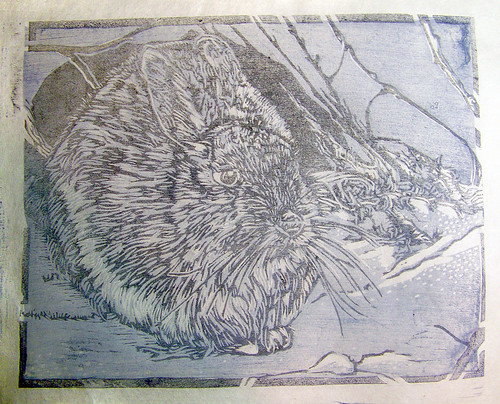I was so excited yesterday when I unpackaged my iMcClain's order containing my new earthtone Aukua Kolor inks and mediums. Bake (pronounced: bah-kay) brushes arrived, too, so I could apply the colors.
I've been wanting to learn traditional Japanese Moku Hanga techniques and have read many books about it. They all suggested using Japanese washi with just the right amount of moisture level, mixing exactly the right amount of watercolor, hide glue and nori for the inks, etc. How could I know what the correct proportions of these things would be? Practice, practice, practice.
Then I am introduced to the idea of Aqua Kolor inks, they can be used dry paper although using damp paper will provide for a more even application on large areas of color. They can be mixed with mediums that will thicken, loosen, blend, extend, retard, or lift the ink offering far more control than the traditional hide glue-watercolor-nori paste mixture. The Akua Kolors can be brushed on or rolled on depending on the consistency of the ink.
I was forced to wait 24-hours before I could try it out. If you know me, you know that is an extremely difficult task. The brushes had to be prepared. Bake brushes need the hairs split to soften them. Traditionally, dried shark skin was used, but a type of heavy duty sandpaper called dragon skin is sold for the purpose today. I had neither, so I used my kitchen grater–the side that that will zest a lemon (don't tell my husband. lol) Then the bristles had to be soaked to tighten them within their wooden base. This way hairs do not fall out and end up embedded in the print.

I made my own registration board and with tremendous thanks to Bette Norcross-Wappner for showing her method of using foam tape to assist lining up the paper properly, my registration was significantly improved!
Priming the Block, originally uploaded by pejnolan.
I had read to use just a few drops of ink when preparing the block to print. So I added three drops and used the bake brush. It immediately was pulled into the board. Again and again and again! I kept trying to add more without going overboard. Finally after about the 13th practice print the board could not take in any more and the ink finally was transferring to the paper sufficiently. So, rule #1 prime the block using newsprint before even thinking about printing on nice paper. (David Bull's e-book "Your First Print" states this very clearly and convincingly; however, being the person I am, I have to learn by actually doing. Do yourself a favor and listen to David!)
I printed quite a few practice pieces as I tried to educate myself how the ink worked. There is more than a little wrong with each of the ones I printed. It is definitely a work in progress. Tomorrow I'm buying more paper: newsprint as well as fine washi. I MUST have at least five these completed and sent to Canada by the 20th of January. So, I'd better learn quickly! After tonight, I think I'll be ok.I can't wait to get back to it!
Tomorrow morning –first thing–I'm going to make corrections to the blocks and tackle printing again tomorrow night. I like to softness of the colors, the visible brushstrokes, the watercolor effect. I'm still excited about the Akua Kolors–to me that is a very good sign! I think this is the start of a beautiful relationship!

1 comment:
Wow!!
A long complicated process but well worth the effort. I absolutely love the result. I grow my own ginger in the garden and have always wanted to make a print.
Post a Comment